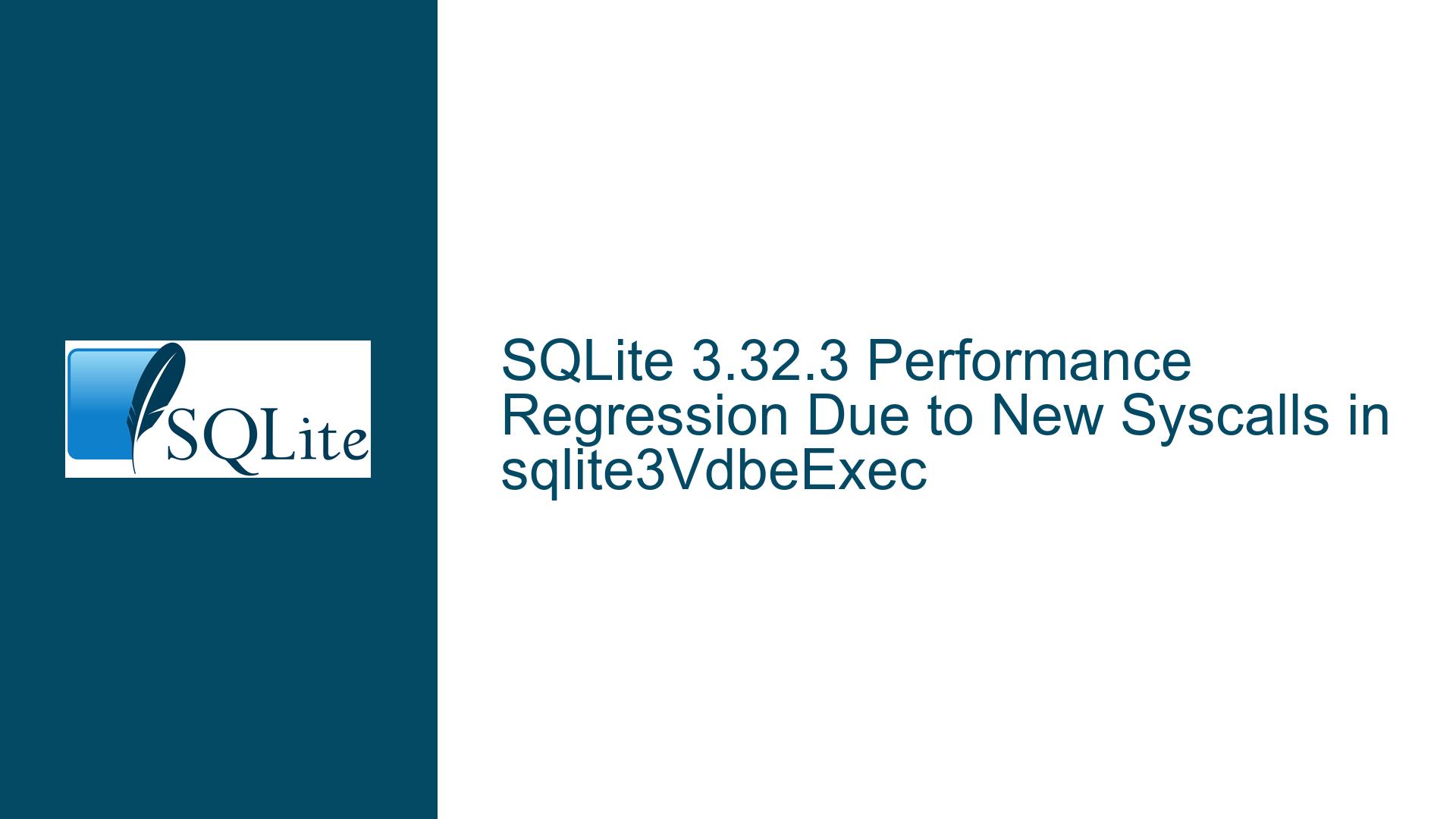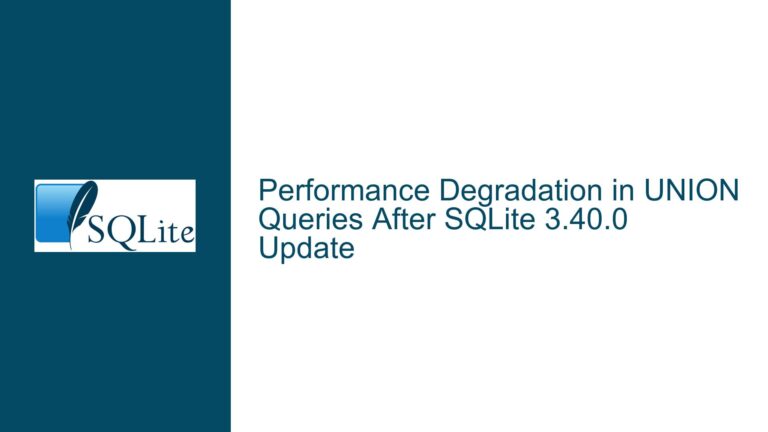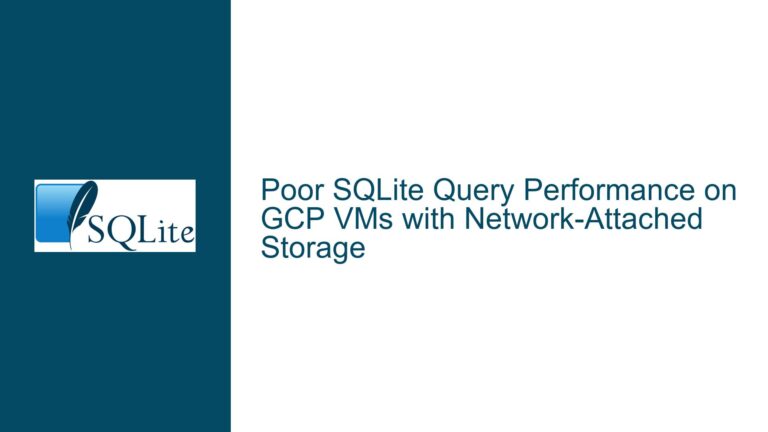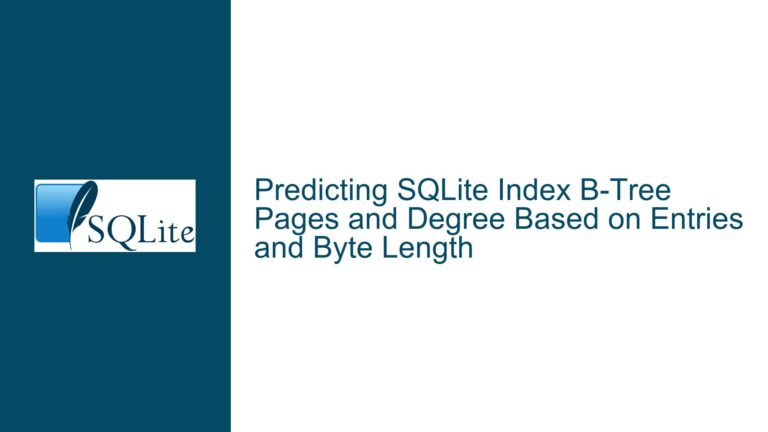SQLite 3.32.3 Performance Regression Due to New Syscalls in sqlite3VdbeExec
SQLite 3.32.3 Introduces Unexpected Syscalls in sqlite3VdbeExec Profiling
When upgrading from SQLite 3.16.2 to SQLite 3.32.3, a significant performance regression was observed in the execution of the sqlite3VdbeExec function. Profiling data revealed that the newer version introduces a substantial number of syscalls during the execution of sqlite3VdbeExec, which were not present in the older version. This behavior was particularly noticeable when querying a virtual table implementation that exposes approximately 600,000 records with two string columns. The virtual table interface calls (vt_filter, vt_eof, vt_column, vt_data) were previously the primary consumers of CPU time, but in SQLite 3.32.3, syscalls now dominate the profile.
The query in question is straightforward: SELECT name, leafname FROM pin_list, which does not involve complex SQL constructs such as joins, constraints, or sorting. This simplicity suggests that the performance regression is not due to changes in the SQLite query planner or bytecode generation but rather to internal changes in the SQLite library itself. The syscalls introduced in SQLite 3.32.3 are not well-documented, and their purpose is unclear, leading to confusion and performance degradation in applications that rely heavily on virtual table implementations.
Changes in SQLite 3.32.3 Bytecode Execution and Syscall Behavior
The introduction of syscalls in sqlite3VdbeExec in SQLite 3.32.3 can be attributed to several factors. First, SQLite 3.32.3 includes numerous internal optimizations and changes to the Virtual Database Engine (VDBE) that may have altered the way certain operations are performed. These changes could include enhancements to memory management, file I/O operations, or locking mechanisms, all of which might result in additional syscalls.
Second, the virtual table interface itself may have undergone changes that affect how data is accessed and processed. For example, SQLite 3.32.3 might have introduced new mechanisms for handling large datasets or improved error handling, both of which could involve syscalls. Additionally, the new version might have added more rigorous checks for data integrity or concurrency control, which could also contribute to the observed syscall overhead.
Finally, the environment in which SQLite is running could play a role. If the application is running on a system with different characteristics (e.g., different file systems, memory management policies, or kernel versions), the behavior of syscalls might differ between SQLite 3.16.2 and SQLite 3.32.3. This is particularly relevant if the syscalls are related to file I/O or memory allocation, as these operations are highly dependent on the underlying operating system.
Diagnosing and Mitigating Syscall Overhead in SQLite 3.32.3
To diagnose and mitigate the syscall overhead introduced in SQLite 3.32.3, several steps can be taken. First, it is essential to identify the specific syscalls that are being made. This can be achieved by running the application under a system call tracer such as strace on Unix-like systems. By analyzing the output of strace, it is possible to determine which syscalls are being invoked and how frequently they occur. This information can then be used to pinpoint the source of the overhead.
Once the problematic syscalls have been identified, the next step is to determine whether they are necessary or if they can be optimized. For example, if the syscalls are related to file I/O, it might be possible to reduce their frequency by increasing the size of the SQLite page cache or by using memory-mapped I/O. Similarly, if the syscalls are related to memory allocation, it might be possible to optimize the memory management settings in SQLite to reduce the number of allocations and deallocations.
Another approach is to isolate the virtual table implementation and test it independently of the larger application. This can be done by dynamically loading the virtual table module into the SQLite shell and running the same queries. By doing so, it is possible to determine whether the syscall overhead is specific to the virtual table implementation or if it is a more general issue with SQLite 3.32.3. If the issue is specific to the virtual table, it may be necessary to review and optimize the implementation to reduce the number of syscalls.
In some cases, it may be necessary to revert to an older version of SQLite or to apply custom patches to the SQLite source code to address the performance regression. However, this should be considered a last resort, as it can introduce compatibility issues and make it more difficult to benefit from future SQLite updates.
Finally, it is important to monitor the performance of the application over time and to keep abreast of new SQLite releases. The SQLite development team is highly responsive to performance issues, and it is possible that a future release will address the syscall overhead introduced in SQLite 3.32.3. By staying informed and actively participating in the SQLite community, it is possible to ensure that the application continues to perform well while taking advantage of the latest SQLite features and optimizations.
Detailed Analysis of Syscall Overhead in SQLite 3.32.3
To further understand the syscall overhead introduced in SQLite 3.32.3, it is helpful to delve into the specific changes that were made between SQLite 3.16.2 and SQLite 3.32.3. One of the most significant changes in SQLite 3.32.3 is the introduction of the "strict" mode for tables, which enforces stricter type checking and can lead to additional syscalls when processing data. This feature is designed to improve data integrity but may come at the cost of increased CPU overhead.
Another change in SQLite 3.32.3 is the enhancement of the WAL (Write-Ahead Logging) mode, which is now the default journal mode for SQLite databases. WAL mode introduces additional syscalls related to file locking and synchronization, which can impact performance, especially in applications that perform a large number of concurrent read and write operations. While WAL mode generally improves performance for most workloads, it can introduce overhead in certain scenarios, particularly when dealing with virtual tables.
Additionally, SQLite 3.32.3 includes improvements to the query planner and optimizer, which may have altered the way certain queries are executed. For example, the new version might generate different bytecode for the same query, leading to changes in the execution profile. While these changes are generally beneficial, they can sometimes result in unexpected performance regressions, particularly in complex or highly customized environments.
To mitigate the impact of these changes, it is important to carefully review the SQLite changelog and release notes for each new version. By understanding the specific changes that have been made, it is possible to identify potential sources of performance regression and take appropriate action. For example, if the syscall overhead is related to the new "strict" mode, it might be possible to disable this feature or to modify the schema to reduce its impact. Similarly, if the overhead is related to WAL mode, it might be possible to switch to a different journal mode or to adjust the WAL settings to better suit the application’s workload.
Practical Steps to Reduce Syscall Overhead in SQLite 3.32.3
In addition to the general strategies outlined above, there are several practical steps that can be taken to reduce the syscall overhead in SQLite 3.32.3. One approach is to use the PRAGMA command to adjust various SQLite settings that can affect performance. For example, the PRAGMA cache_size command can be used to increase the size of the SQLite page cache, which can reduce the number of file I/O operations and, consequently, the number of syscalls. Similarly, the PRAGMA synchronous command can be used to adjust the level of synchronization required for write operations, which can also impact the number of syscalls.
Another approach is to use the PRAGMA journal_mode command to switch to a different journal mode. For example, switching from WAL mode to DELETE mode can reduce the number of syscalls related to file locking and synchronization, although this may come at the cost of reduced concurrency. It is important to carefully evaluate the trade-offs involved in changing the journal mode, as this can have a significant impact on both performance and data integrity.
In some cases, it may be necessary to modify the virtual table implementation itself to reduce the number of syscalls. For example, if the virtual table performs a large number of small I/O operations, it might be possible to batch these operations together to reduce the overall number of syscalls. Similarly, if the virtual table uses a large amount of memory, it might be possible to optimize the memory management to reduce the number of allocations and deallocations.
Finally, it is important to consider the broader context in which SQLite is being used. For example, if the application is running on a system with limited resources, it might be necessary to optimize the overall system configuration to reduce the impact of syscall overhead. This could include adjusting the system’s memory management settings, optimizing the file system, or even upgrading the hardware to better support the application’s workload.
Conclusion
The introduction of syscall overhead in SQLite 3.32.3 is a complex issue that can have a significant impact on the performance of applications that rely heavily on virtual table implementations. By carefully analyzing the specific syscalls that are being made, understanding the changes that were introduced in SQLite 3.32.3, and taking practical steps to mitigate the overhead, it is possible to address this issue and restore the application’s performance. While this process can be challenging, it is essential for ensuring that the application continues to perform well in the face of evolving SQLite versions and changing workloads.






